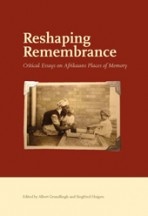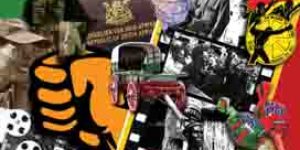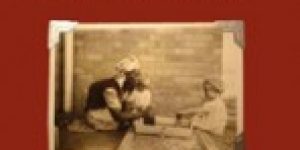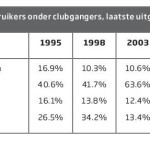Reshaping Remembrance ~ Koos Kombuis And Collective Memory: An Introduction
No Comments yet As the year 2006 gave way to 2007, a song and an accompanying music video about the Boer general Koos de la Rey caused quite a stir in South Africa. When this song was played in bars and at barbecues, young white Afrikaners would stand with their fists clenched against their chests and sing along: ’De la Rey, De la Rey…’ And tears would flow. According to news reports, the ‘De la Rey thing’ had made many of them ‘proud’ of their roots. Worried ANC politicians expressed concern because they saw this as the start of an ethnic revival that could disrupt South Africa. The phenomenon even made it to the world press.
As the year 2006 gave way to 2007, a song and an accompanying music video about the Boer general Koos de la Rey caused quite a stir in South Africa. When this song was played in bars and at barbecues, young white Afrikaners would stand with their fists clenched against their chests and sing along: ’De la Rey, De la Rey…’ And tears would flow. According to news reports, the ‘De la Rey thing’ had made many of them ‘proud’ of their roots. Worried ANC politicians expressed concern because they saw this as the start of an ethnic revival that could disrupt South Africa. The phenomenon even made it to the world press.
One of the more balanced reactions to the De la Rey song is an article by the Afrikaans beat poet Koos Kombuis on Litnet, ‘Bok van Blerk en die bagasie van veertig jaar’ (Bok van Blerk and the baggage of forty years).[i] In this article Kombuis confesses his conflicting reactions to the song. Rationally, he rejects the song and the Boer War elements in the music video. He sees it as ‘a call to war, a sort of musical closing of the ranks’. Some months before Kombuis had distanced himself publicly from his Afrikaner identity in a Sunday newspaper, from the ‘baggage that has been forced on me by people who have now been trying to prescribe for forty years who and what an Afrikaner is. What an Afrikaner is supposed to believe in. Whom he should vote for, which shit clothes he should wear and how he should spend his public holidays’.[ii] This notwithstanding, Kombuis is unable to offer any resistance to the emotional appeal of the song: ‘Why, if I experienced my resignation from Afrikanerdom as such a gloriously liberating step, do I feel so inexplicably profoundly touched by the De la Rey song? It is embarrassing’.
In reply to Kombuis’s question ‘why’, it can be surmised that both the song and the video, with their images of the leadership, a concentration camp and Boer fighters, draw on the collective memory of white Afrikaners, on something they learned within the family and, especially for the older ones, at school and in church. Kombuis’s reaction already points in this direction when he says that when he hears the song, he longs to be back at Sunday school and ‘feels like rejoining the army on the spot and shooting the hell out of the Kakies and other K stuff’.[iii]
The role of collective memories was first investigated seriously by the French sociologist Maurice Halbwachs in his ground-breaking works Les cadres sociaux de la mémoire (The social frameworks of memory) and La mémoire collective (The collective memory). These publications from 1925 and 1950 were rediscovered in recent years by historians doing research on memory. According to Halbwachs, every one of us obviously has his own memories, but at the same time we also share group memories.
One remembers as an individual, but in this one is not alone. The environment in which one grew up and in which one lives forms a framework which determines the shape and content of memories and helps to codetermine identities. Groups can even produce memories in individuals which they never ‘experienced’ in a direct sense.
Collective memories are fluid as regards past events. The interests and requirements of the present determine collective memory. As generations pass, memories fade away. The period of collective memory is generally estimated as going back one hundred years from the present. Within the confines of three or four generations, the past still remains ‘warm’ – it maintains a link with the living. The past predating this period cools down and becomes part of the domain of historical memory, the terrain that is kept alive artificially by specialist historians. Here, too, the influence of the present is not absent, because only certain aspects of the vast area encompassed by the past are researched by historians.[iv]
Halbwachs argues that social groupings form the memories and identities of individuals. Kombuis’s compulsive thoughts of Sunday school and the South African Defence Force also indicate the direction in which his reactions to the De la Rey song are determined. It was Sunday school and the Defence Force, among others, that shaped his memories and that cause him to be touched by the De la Rey song.
The book Reshaping Remembrance contains a series of critical essays about a number of collective Afrikaans memories – memories which have already almost gone cold as well as the more recent ones, such as the De la Rey song. The original Afrikaans version of the book sought to encourage Afrikaans readers to reflect on their memories. It may be gratifying to get high and forget about things that bother you and feel proud of your origins, but it would be unwise to suppress the problematic aspects of the past. It is, for one thing, not conducive to dialogue with other citizens of South Africa. Given the burden of apartheid guilt, the memories of Afrikaans-speaking whites cannot unfold in the present without reservations or nuances. ‘They’ will still hold you responsible, no matter how hard you try to forget. After all, at present it is ‘they’ who set the debate, who put whites more or less in the position of the ‘other’. Censured, sanitised memory is not healthy either. It is better to come to grips with the past, not to push it away behind a barrier of protective wishful thinking. Freud showed that the latter could cause nightmares.
The approach followed in this book differs from the way in which the collective memories of Afrikaners were dealt with twenty years ago. In the publication of the Federation of Afrikaner Cultural Bodies (FAK), Afrikanerbakens (Afrikaner beacons) of 1989, a series of historical monuments, resorts, church buildings and statues were described. ‘Together they want to express the story of the Afrikaner’, as the editor put it.[v] The style in which the ‘beacons’ were described was not detached from the spirit of the time prevailing in the late 1980s, when the National Party was coming under increased domestic and foreign pressure because of apartheid. With white domination tottering and the future uncertain, a need was felt to leave a tangible record of what could be regarded as ‘Afrikaner beacons’ for posterity. But at the present juncture even the concept of ‘Afrikaner beacons’, with its associations of immutability and prescriptiveness, is an anomaly.
In this book on collective memory among Afrikaners, the contributors have examined so-called memory sites. This term does not necessarily refer to physical, topographic sites. Following in the footsteps of Pierre Nora and Jan Assmann, the term memory site is used in a metaphorical sense in this book. According to Assmann and Nora the collective memory ‘crystallizes’ around certain points of attachment to the past that develop into symbolic figures. In this way the past develops into a reality that has a persistent formative force. Such sites of memory can be both material and immaterial: buildings, places, events, acts, books, people. In media theory terms, one could call them icons. Such places are memory sites not because of their materiality, but because of the symbolic function that they fulfil. ‘Site’ is therefore also understood here in the metaphoric, heuristic sense, much in the same way as a topos in classical rhetoric. At a memory site, memories are found. The memories can be consoling, but often painful as well. Take examples of German memory sites: there are the fairytales of Grimm and the poet Goethe, but also Hitler’s bunker in Berlin, the Berlin Wall and Auschwitz.[vi]
Although this book links up with similar books such as the French Les lieux de mémoire (The Realms of Memory, 1981-1992), the German Deutsche Erinnerungsorte (German Places of Memory, 2001) and the Dutch Plaatsen van Herinnering (Places of Memory, 2005-2006), it differs from these in that we have restricted ourselves to the past century. Afrikaners as an ‘imagined community’, a group of individuals who view themselves as a nation, have not been in existence for much more than a century, according to the Afrikaans historians Floris van Jaarsveld and Hermann Giliomee. Moreover there is a trend, even among Afrikaans-specialist historians, to restrict historical interest to the preceding century. At the time when the Great Trek as commemorated, historical interest still went back as far as 1838, but at present the Anglo-Boer War increasingly seems to be the limit. European historical consciousness goes back further and is more strongly established, because until recently the French, for example, were still taught that the Gauls were their ancestors. The shorter time frame is another reason why this book covers a smaller scope than the multivolume European works.
The book ignores more potential topics than it includes. The limited pool of Afrikaans researchers available and their particular research interests more or less dictated the choice of topics for this book. For example, we as editors would also have liked to include essays on the Dutch Reformed Church, the Pickup Truck and the Ox Wagon, the secret Afrikaner Broederbond and the National Party, the poets Breyten Breytenbach and Ingrid Jonker, the Border of the Republic and the Army, the Afrikaans publishing giant Naspers and the South African Broadcasting Corporation, the Farm and the Small Town, the General Dealer, the South African Railways, the Mine and the Kruger National Park, Verwoerd and Mandela, Mandela’s Afrikaans defence lawyer Braam Fischer, the Soweto Uprising in 1976, the university town of Stellenbosch and Pretoria, the capital of South Africa. As it is, the book covers both material and immaterial culture, the sublime and the banal, with a special emphasis on race and language, because these two elements used to dictate who was considered to be an Afrikaner.
The following contributions are essays such as Montaigne understood this genre – writings in which certain problems are examined in a personal way. The essays were expected to contain critical analyses of memory sites. Each contributor was allowed to choose his or her own emphasis within the overarching point of departure of the book. The authors’ brief was also to do this with detachment in order to stimulate the reader to reflect on the subject instead of identifying himself or herself emotionally with it. However, maintaining a critical distance does not of necessity exclude intense involvement with the material.
NOTES
i. Litnet, 28 November 2006.
ii. Rapport, 15 January 2006.
iii. Also compare Grundlingh’s essay on the ‘De la Rey’ song in this book.
iv. classiques/Halbwachs_maurice; P.Nora, ‘Between memory and history: Les Lieux de Mémoire’, in: Representations, Spring 1989, 7-24; P.H. Hutton, ‘Sigmund Freud and Maurice Halbwachs: The problem of memory in historical psychology’, in: The History Teacher, February 1994, 145-158; J. Assman, ‘Collective memory and cultural identity’, in: New German Critique, Spring/Summer 1995, 125-133; S.A. Crane, ‘Writing the individual back into collective memory’, in: The American Historical Review 102(5), 1997, 1372-1385; J.K. Olick & J. Robbins, ‘Social memory studies: From ‘collective memory’ to the historical sociology of mnemonic practices’, in: Annual Review of Sociology 24, 1998, 104-140; J.K. Olick, ‘Collective memory: The two cultures’, in: Sociological theory 17(3), 1999, 333-348; P. Hutton, ‘Recent scholarship on memory and history’, in: The History Teacher, August 2000, 533-548.
v. M.J. Swart et al. (eds), Afrikanerbakens. Auckland Park: FAK 1989.
vi. F. Yates, The art of memory, London 1966; P. Nora, ‘Between memory and history: Les Lieux de Mémoire’, in: Representations, Spring 1989, 7-24; J. Assman, ‘Collective memory and cultural identity’, in: New German Critique, Spring/Summer 1995, 125-133; E. François & H. Schulze (eds), Deutsche Erinnerungsorte, I. Munich 2001, 9-24; H.L. Wesseling, Plaatsen van herinnering. Een historisch successverhaal. Amsterdam 2005.
References
Assmann, J. ‘Collective memory and cultural identity’, in: New German Critique 65 (1995), 125-133.
Crane, S.A. ‘Writing the individual back into collective memory’, in: The American Historical Review 102 (1997), 1372-1385.
François, E. & Schulze, H. ‘Einleitung’, in: E. François & H. Schulze (eds.), Deutsche Erinnerungsorte. Volume I. Munich: Beck 2005, 9-24.
Halbwachs, Maurice Les cadres sociaux de la mémoire. Paris: F. Alcan 1925. [Online: http://classiques.uquac.ca/classiques/Halbwachs_maurice.]
Halbwachs, Maurice La mémoire collective. Paris: Presses Universitaires de France, 1950.
[Online: http://classiques.uquac/classiques/Halbwachs_maurice.]
Hutton, P.H. ‘Sigmund Freud and Maurice Halbwachs: The problem of memory in historical psychology’, in: The History Teacher 27 (1994), 145-158.
Hutton, P. ‘Recent scholarship on memory and history’, in: The History Teacher 33 (2000), 533-548.
Kombuis, K. ‘Bok van Blerk en die bagasie van veertig jaar’. Litnet, 28 November 2006 [Online: www.litnet.co.za/cgi-bin/giga.cgi?cmdcause_dir_news_item&cause_id=1270&news_id=6473&cat_id=163].
Nora, P. ‘Between memory and history: Les Lieux de Mémoire’, in: Representations 26 (1989), 7-24.
Olick, J.K. & Robbins, J. ‘Social memory studies: From ‘collective memory’ to the historical sociology of mnemonic practices’, in: Annual Review of Sociology 24 (1998), 104-140.
Olick, J.K. ‘Collective memory: The two cultures’, in: Sociological theory 17 (1999), 333-348. Rapport, 15 January 2006.
Swart, M.J. et al. (eds), Afrikanerbakens. Auckland Park: FAK 1989.
Wesseling, H.L. Plaatsen van herinnering. Een historisch successverhaal. Amsterdam: Bert Bakker 2005.
Yates, F. The art of memory. London: Routledge and Kegan Paul 1966.
You May Also Like
Comments
Leave a Reply




